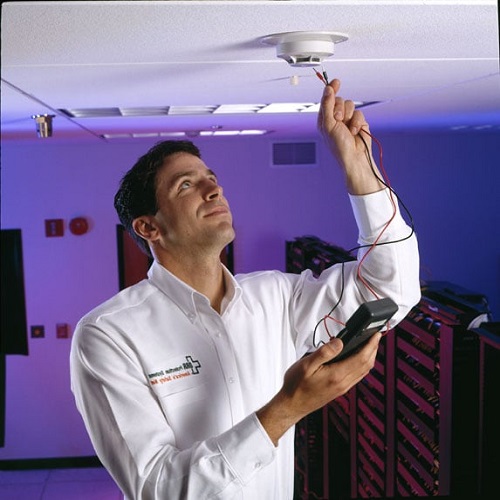
Fire Alarm
Detection Service:
Fire alarm
servicing is typically broken down into different frequencies and levels of
detail.
Daily/Weekly
Checks (User-level): These are simple, routine checks that can often
be performed by a designated person on-site. They involve a visual inspection
of the control panel to ensure no fault or fire signals are present (often
indicated by a green LED), and a weekly test of a different manual call point
(pull station) to ensure the alarm sounds.
Monthly/Quarterly
Inspections (User-level): These are more detailed inspections that
include checking batteries, ensuring all devices are free from physical damage
or obstruction, and verifying that the system is properly logged.
Semi-Annual/Annual
Professional Maintenance: This is a comprehensive service performed by
a certified fire alarm technician. It is a legal requirement in many
jurisdictions and is essential to maintaining the system's operational
integrity.
Key Aspects
of a Professional Service
A professional
fire alarm service for detectors and the overall system generally includes:
1. Functional
Testing of Detectors:
Smoke
Detectors: Technicians will use a specialized aerosol "test
smoke" to simulate the presence of smoke and confirm that the detector
goes into alarm.
Heat
Detectors: A heat gun or similar device is used to apply heat to the
detector until it activates at its specified temperature.
Manual Pull
Stations: Each pull station is physically activated to ensure it sends
the correct signal to the control panel and triggers the alarm.
Beam
Detectors and Aspirating Systems: These more complex systems require
specific tests to verify their functionality.
2. Sensitivity
Testing and Cleaning:
Dust and dirt
can significantly affect the sensitivity of smoke detectors, leading to false
alarms or, more dangerously, a failure to detect a real fire.
Technicians
will use a professional tool to measure the sensitivity of the detector's
chamber. If it's outside the manufacturer's specified range, the detector will
be cleaned with a vacuum or compressed air. If cleaning doesn't restore the
correct sensitivity, it must be replaced.
3. Battery
and Power Supply Checks:
The service
includes testing the backup batteries to ensure they can provide power to the
system for the required duration during a power outage.
This often
involves a discharge test to confirm the battery's capacity and voltage.
Batteries are typically replaced every five years, but this can vary.
4. System-Wide
Checks:
Control
Panel: The technician will inspect the main control panel for any
fault codes, ensure all wiring is secure, and check the software and firmware
versions.
Audible and
Visual Alarms: All horns, sounders, and strobes are tested to confirm
they are functioning and are not obstructed.
Interface
with Other Systems: Fire alarms are often integrated with other
building systems, such as smoke vents, fire doors, lifts, and fire suppression
systems. The service will test these interfaces to ensure they respond
correctly.
5. Documentation
and Reporting:
A detailed
report is a mandatory part of the service. It should include the date and time
of the service, the name of the technician, a list of all devices tested, and
their individual test results.
Any issues found, along with recommended corrective actions, must be noted. This service log is a crucial document for regulatory audits and compliance.